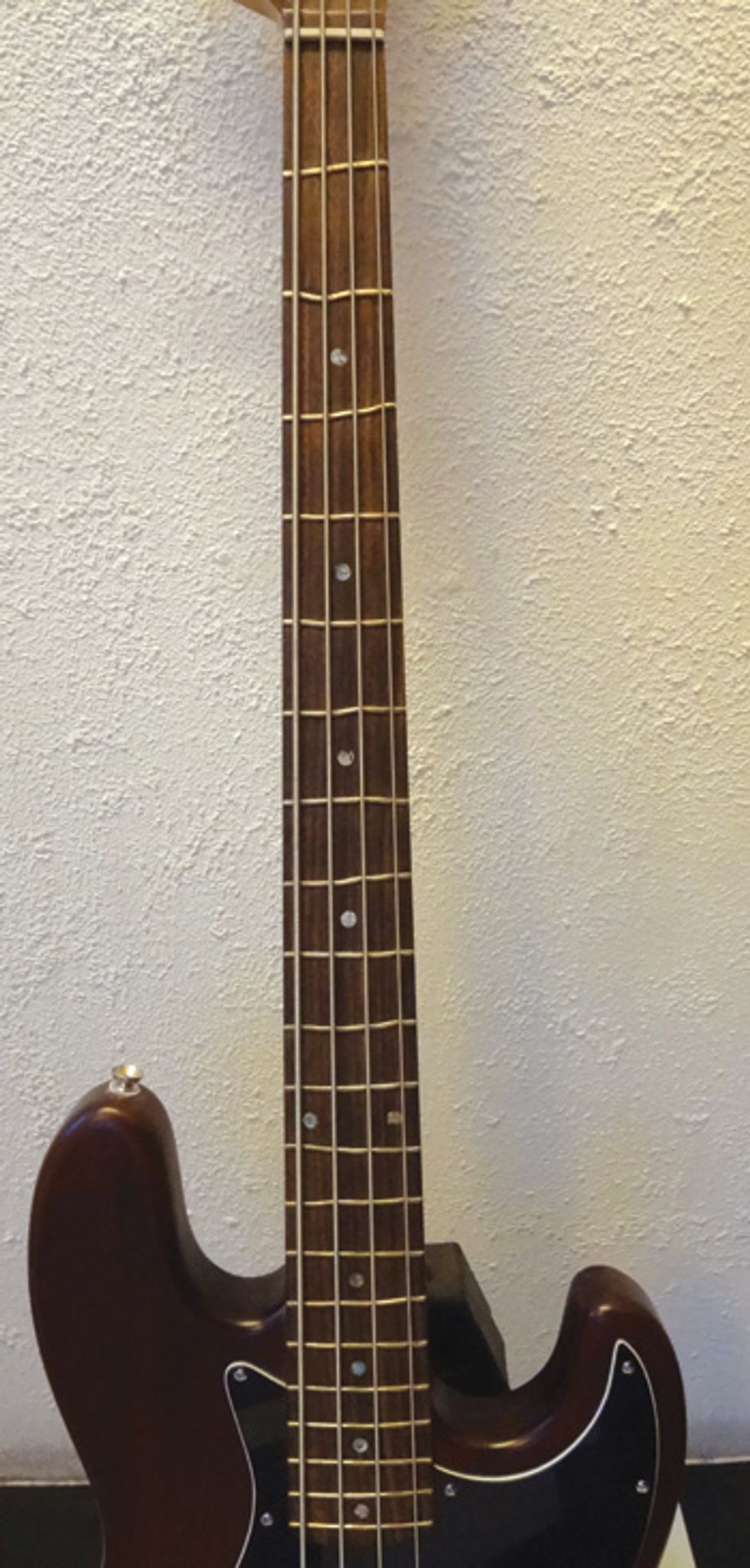
No, you don’t need new glasses: This is a 4-string fretboard equipped with True Temperament frets.
The fretboard: It’s where we focus most of our practice time and that means we stare at it a lot. It’s interesting how today’s fretboards look exactly the same as in the old days. We’ve seen some changes in fretboard radius over time, but even the fret material has remained consistent for the vast majority of instruments. True, we now have stainless steel frets, which were developed to reduce fret wear, but most manufacturers don’t push this material, as it’s way harder to work with than standard fretwire.
What bassists have used for decades is a ’board with straight frets, and fret position is calculated using a constant divisor. This way, the 12th fret ends up exactly in the middle of our scale length. The math behind this divisor is very accurate and the system seems to work well—after all, a lot of great music has been made with it. (Note: We’re not talking about different tunings. This discussion is all about getting accurate pitches in standard tuning.)
The mathematic model behind fret distances is an approximation of an ideal string. We have to make some shifts from the ideal to accommodate real-world parameters, and one of these parameters is the stiffness of the string. The further we reach up the fretboard, the more this plays a role in the resulting pitch. Another factor is mass and whether a string is wound or plain, although plain strings are something that only a few extended-range bassists will ever have to deal with.
On a traditional fretted instrument, our only key to adjusting intonation is the bridge, and it can only do one compromised adjustment for the entire scale length. The result is that our intonation will only work well for a certain area of the fretboard.
You could say that the system works fine the way it is, but some creative minds have come up with interesting ideas that at least shed some light on our workspace and its limitations. Most of these ideas initially focused on the guitar market, as a guitar’s higher notes show the effect of various systems more prominently, but when it comes to stiff, heavy, and thick strings, well, we own that world. Let’s look at a few of these ideas for improving intonation.
The Earvana nut. These replacement nuts are easy, non-permanent mods that offer an alternative intonation system. The principle is that the nut is no longer straight, and it provides a compensation that’s similar to the bridge. The nut position, and therefore scale length, is slightly altered for each of the strings.
Once a non-straight nut is installed, the bridge will need a new setup. This mod makes the biggest difference in the range of the first frets. Claims that a compensated nut works over the entire range seem to be a bit over the edge and probably depend on how closely you look at the data, but this technology surely helps overall intonation.
The Circular Fretting System. The idea behind the Circular Fretting System (C.F.S.) is that the strings, coming from the nut, are not parallel. They are indeed slightly divergent, and on a 4-string bass, the outer strings are shifted sideways about 10 mm. That means that the outer strings “see” a slightly larger scale length.
To compensate to an equal scale and make all strings cross the fret at an exact angle of 90 degrees, the C.F.S inventors curve the frets. Installing curved frets involves way more work than classic straight frets, so let’s look at the inventor’s claims to weigh the benefits. For starters, it’s claimed the equaled scale will make an “extremely accurate pitch” and “sharply defined tone.” The exact 90-degree crossing delivers a “longer sustain, sonorous harmonics, bell-clear sound, and a fast resonance.” Sounds like it’s worth the additional work to install curved frets.
Here are the numbers for a traditional 34"-scale bass: The additional scale length of the outer strings is 0.002" or 0.06 mm, and the strings cross the frets at an angle of 89.9998 degrees, instead of exactly 90 degrees. But because even the most accurate fingering will generate bigger variations in this angle, there will be no intonation benefit to having an exactly equal scale length for different strings. Also, the aforementioned divisor still generates the same inaccuracies. And every slightly bent note on any fretboard would, to use circular fretting terms, create a less sharp tone and impact the harmonics and sustain. Somehow this conflicts with experience.
True Temperament fretting. At first sight, this is pretty wild! It represents the most laborious fretwork one can do, as it keeps track of the real pitch of each and every note on the fretboard with a corrected fret position, and almost none of the frets remain straight. Additionally, the Swedish company behind this technology produces fretboards with a variety of temperaments, including 12-tone equal, Wohltemperierte Gitarre, Thidell Formula 1, low-tune guitar, and bass guitar. Each of these serve a special purpose and is a world of its own.
Alternative intonation systems can inspire you to dig deep into the tradition and evolution of musical instruments. It’s a fascinating journey, but for not everyone—in fact, some players love their basses for their impreciseness. A final thought: If you chose to explore this sonic world, you’d better convince your guitar-playing bandmates to do the same.
 Heiko Hoepfinger is a German
physicist and long-time bassist, classical
guitarist, and motorcycle enthusiast. His
work on fuel cells for the European orbital
glider Hermes got him deeply into modern
materials and physical acoustics, and
led him to form BassLab (basslab.de)—a
manufacturer of monocoque guitars and basses. You can
reach him at chefchen@basslab.de.
Heiko Hoepfinger is a German
physicist and long-time bassist, classical
guitarist, and motorcycle enthusiast. His
work on fuel cells for the European orbital
glider Hermes got him deeply into modern
materials and physical acoustics, and
led him to form BassLab (basslab.de)—a
manufacturer of monocoque guitars and basses. You can
reach him at chefchen@basslab.de.






![Rig Rundown: AFI [2025]](https://www.premierguitar.com/media-library/youtube.jpg?id=62064741&width=1245&height=700&quality=70&coordinates=0%2C0%2C0%2C0)












 Shop Scott's Rig
Shop Scott's Rig


![Rig Rundown: Russian Circles’ Mike Sullivan [2025]](https://www.premierguitar.com/media-library/youtube.jpg?id=62303631&width=1245&height=700&quality=70&coordinates=0%2C0%2C0%2C0)












































